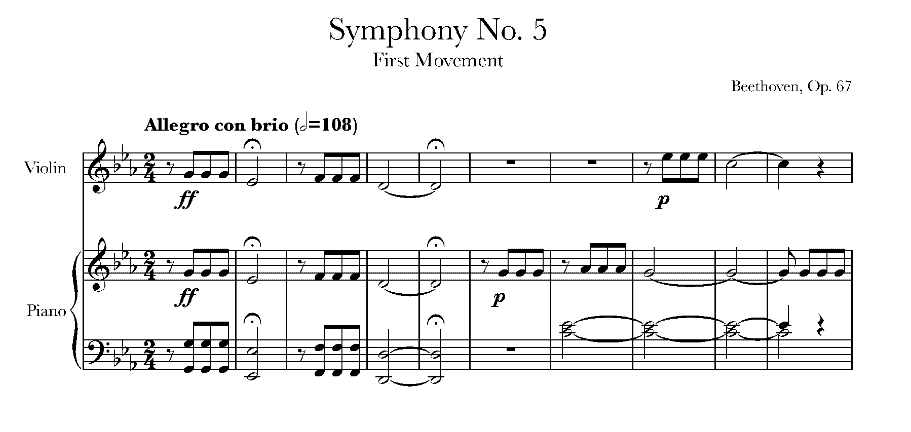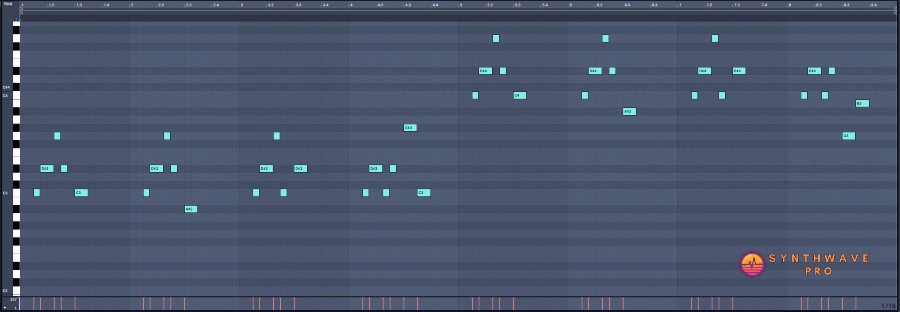Synthwave melodies are what draws a listener to pay particular attention to a track. In fact, soaring melodies, memorable hooks and a dazzling flurry of notes is what sets your track apart from other aspiring synthwave producers. In this tutorial, we’ll uncover strategies for formulating catchy synthwave melodic hooks that will keep your listeners engaged.
Question: How to make synthwave melodies?
Answer: To make a compelling synthwave melody, create a musical motif made up of chord tones, repetition and transposition.
While the motif stands to be the initial musical idea behind the melodic theme, it is often repeated, altered and manipulated throughout the composition therefore adding to the overall tension and release phases of a soundtrack.
What Makes a Melody Memorable?
The most basic melodies are made up of simple elements that, when combined, create a memorable hook that embeds itself into the hearts and minds of listeners. For instance, the melodic motif, a musical element that is typically a short sequential component, can provide the basis for which a song can begin developing over the course of an entire arrangement.
What is a Melodic Motif?
A motif, in its purest form, is that which is stated, developed and embellished throughout a composition offering a variety of palatable choices for which a listener latches onto. Similarly, the end product of a savory Idaho potato can be presented in a variety of ways – mashed, boiled, baked, french fried and hashed. The motif, as we will discover, is no different in that it mutates to provide the building blocks for which songwriters can explore musical outcomes while creating a cohesive melodic soundtrack.
Take for instance Ludwig van Beethoven’s Symphony No. 5, Op. 67: I. Allegro con brio.
Beethoven’s instantly recognizable musical masterpiece is made up of a 4 note musical motif that is repeated, transposed and embellished throughout the score.

By and large, crafting compelling melodic material without formal music theory is without a doubt extremely challenging especially for inexperienced composers..
Here are a few suggestions to help create melodies that resonate.
Make a Chord Progression and Melodic Motif Using a Piano
Before instantiating your favorite plugin, start with an instance of a piano VST. Most DAWs (digital audio workstations) ship with stock pianos which are more than enough to get things going.
Next, record the chords to your song and its accompanying melodies. Similarly, you can do this with a guitar as well if it’s your primary instrument.
While most EDM artists cringe at the idea of relying on a piano as compositional tool, be aware that jazz musicians from yesteryears would often turn to the piano to flesh out chords, harmonies and melodic ideas despite playing an entirely different instrument. In the same fashion, many of today’s musicians, including pop stars such as Lady Gaga and Justin Bieber all have some kind of piano training that has proven to be effective for songwriting.
The purpose of using the piano is to plan out chords, melodies and supportive elements in the form of harmonies and brief musical runs. Equally important is the creation of variations of our primary melodic theme so be sure to record those bits as well. Ableton’s session view lends itself for the quick recording of melodic variations so be sure to harness the power of this convenient feature.
By and large, there is nothing wrong with instantiating your favorite plugin in an attempt to kickstart the songwriting process, but keep in mind that if you work out your chords and melodic structure early on with a piano, translating those ideas to “fancier” plugins become infinitely easier.

Make Synthwave Melodies Within The Confines of Boundaries
Let’s imagine you have a chord structure already laid out but fail to come up with a catchy melody. This can happen when you noodle around with a few chords that sound great together despite being unable to “hear” a clear melodic theme. The challenge now becomes drawing in a melody. To overcome this dreaded scenario, try to set limits and boundaries.
In other words, choose a set of parameters designed to guide you during this melody creation exercise. Committing to these guidelines prevents you from stagnating while prompting you to move forward quickly to finish a song.
Below are a few examples of boundaries.
- Create a musical motif using a predetermined amount of notes. Eg. 3, 4, 5 or 6 note motif
- Determine the length in bars of the melodic theme (4, 8, 16 bars)
- Use the same guidelines as listed above to create supporting musical elements such as runs and melodic fills
- Use the same guidelines to create harmonies that compliment the melodic lead
Here’s an example of a 5-note motif
It should be noted that these guidelines are used to keep our melody creation process confined to a predetermined set of rules. Some may find this to be restrictive – even to the point of it being “uncreative” however the guidelines are used as a starting point. The restrictions represent a starting point that inevitably forces you to get started while encouraging you to overcome writer’s block. For instance, limiting a motif to 5 notes means that you only need to come up with five notes in order to craft a motif.
Later on, as your composition takes shape, you can alter the original motif by using transposition, shape-altering strategies and layering techniques to add interest throughout the course of the song.
Be sure to adapt the guidelines to suit the needs of your composition during the songwriting process. For instance, if you’ve originally settled on using a 4-note motif but quickly discover that your melodic lead sounds better as a 6-note motif, then go ahead and make those alterations.
Remember, the limits are only there to kickstart the songwriting process – while it is useful it is flexible and should conform to the overall vibe of a composition. By the same token, the limitations are subject to the overall vibe of a song and as such, are flexible and ever changing.
Chord Tones Create The Best Melodies
While you may already have an idea of what your song’s melodic lead line might consist of, it’s not a bad idea to use chord tones found in the song’s chord structure. For this to happen, you can use Ableton clips loop bar to ensure that most of the notes stemming from the melody are found within your chords. To do this, while selecting two MIDI regions (melody and chord clips) in Ableton’s arrangement view, click on the MIDI clips loop bars (image below).
Doing this superimposes the MIDI data of both clips so that they appear in the arrangement’s piano roll thus making it easier to visualize that the notes to our melody are made up of mostly chord tones. See video below
Typically, the notes of a lead line are higher in pitch in comparison to the chord clip to be sure to drop the notes of the lead line to ensure that it is indeed a chord tone.
Creating Melodic Call and Responses for Dynamics
Now that we’ve recorded melodies it’s time to develop potential melodic phrases that will peak the interest of our listener. Most of the time, this is done by introducing call and response sequences. The most effective call and response patterns involve adding another instrument that “responds” to the melody’s original call. For instance, responses usually fill in the gap and are inserted into the areas of the piano roll where the melody ceases from playing. By and large, these musical responses should adhere to chord tones while borrowing elements from the original motif.
Harness The Power Of Transposition
If you’re looking for tricks to extend your arrangements while keeping things fresh then try using a technique that not only pop and orchestral producers have been using for decades, it’s guaranteed to inadvertently engage your listener.
To extend your arrangement, simply duplicate your initial melodic lead line and pitch it up an entire octave. This only works when the lead line is initially played at a range that isn’t too high or too low. This technique emphasizes the power of repetition in that the second time around, the sequence will have your listener sing along to the lead line that is now an octave higher.

Similarly, you can always layer the second reiteration with another instrument for added excitement.
Repeat and transpose the melodic theme one octave higher
Finding Inspiration in Similar Sounding Music
If you’re looking for creative means for coming up with techniques that create compelling melodies try the following strategy. Listen to the compositions of artists in your chosen genre and draw inspiration from their work. This means listening intently to their production style. Moreover, take note of the creative ideas which make up with melodic elements of their composition and use them to your advantage. That being said, it’s crucial that you don’t outright copy or imitate the work too closely. For instance, if you are drawing inspiration from a composer who frequently uses 3-note motif as the basis of their sound, they try to use a 4-note motif. Be creative and shift things around.
Remember that infringing on another artists work is never a cool idea so you’ll have to be careful not to overstep your boundaries.
- Parallel compression for synthwave drums
- Synthwave drums reverb tutorial
- Kick drum layering techniques
- Synthwave bass tutorial
- How to use foreshadowing on a synthwave track
- How to create a whisper track
- How to add VHS tape noise to a Synthwave track
- How to create better transitions arrangements
- Learn how to program a synthesizer like a pro
- Download the Synthwave Pro Free Drum Selector
- Enroll in the SynthwavePro Masterclass
Conclusion
The techniques outlined above only represent a framework on which we can begin to compartmentalize the melody creation process. By no means is this the gold standard for making compelling melodies. On the other hand, when you’re faced with a deadline and absolutely need to move forward, the tips and tricks listed in this article provide actionable steps you can take to form the initial songwriting building blocks.
Recent Posts
What’s the Most Frustrating Part of Making Music And How to Overcome It
Music creation can be one of the most rewarding forms of self-expression. But let’s be honest—it can also be maddening. That moment when inspiration strikes… only to be blocked by technical...
Finding time to produce music while managing a job can be challenging, but several strategies can help you balance both effectively. Prioritize Music Production Make music a priority in your...

